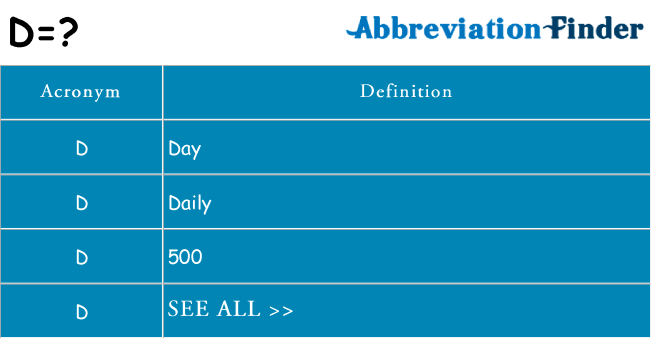What Does "D" Stand for in Measurements? Exploring its Meaning
In the world of measurements, various units and symbols are used to denote different quantities. One commonly encountered symbol is "D," which appears in various contexts and measurements. Understanding the meaning of "D" in measurements is crucial for accurate interpretation and communication. In this article, we will delve into the significance of "D" in measurements, exploring its different applications and the meanings it carries in specific contexts.

What does "D" stand for in measurements?
1. Introduction to Measurement Symbols
Before we explore the meaning of "D" in measurements, let's establish a foundation by understanding measurement symbols.
Measurement symbols are used to represent specific units, dimensions, or quantities in various fields, such as science, mathematics, engineering, and more.
These symbols provide a standardized way to express measurements consistently.
2. The Multiple Meanings of "D" in Measurements
The symbol "D" can represent different quantities or units depending on the specific measurement system or context. Here are a few instances where "D" is commonly used:
a. Diameter: In geometry and engineering, "D" often represents the diameter of a circle or sphere. The diameter is the length of a straight line passing through the center of the circle or sphere, connecting two points on its circumference.
b. Density: In physics and chemistry, "D" can represent density, which is the measure of mass per unit volume of a substance. It quantifies the compactness or concentration of matter.
c. Distance: In various applications, "D" may represent distance, which refers to the amount of space between two points. For example, in transportation and navigation, "D" can denote distance traveled or the length of a route.
d. Dew Point: In meteorology and climatology, "D" is often used to represent the dew point, which is the temperature at which the air becomes saturated and condensation occurs, leading to the formation of dew.
e. Diffusion Coefficient: In scientific and engineering contexts, particularly in fields such as physics and chemistry, "D" can represent the diffusion coefficient. It describes the rate at which particles or molecules spread through a medium due to random motion.
f. Diode: In electronics, "D" may refer to a diode, which is an electronic component that allows the flow of electric current in one direction while blocking it in the opposite direction.
3. Specific Measurement Units
In addition to the various quantities mentioned above, "D" is also used as a symbol for specific units of measurement. Here are a few examples:
a. Decibel (dB): In acoustics and telecommunications, "D" represents the decibel, which is a unit used to measure the intensity or relative power of sound or signal levels.
b. Day (d): In calendars and timekeeping, "D" stands for "day," a unit of time equal to 24 hours or the period of rotation of the Earth on its axis.
c. Degree (°): In trigonometry and geometry, "D" is commonly used to represent degrees, which measure angles.
4. Understanding Context for Clarity
To accurately interpret the meaning of "D" in measurements, it is crucial to consider the specific context in which it is used. The surrounding information and units associated with "D" can provide valuable clues to its intended meaning. Additionally, referring to relevant measurement standards, textbooks, or specific fields of study can help clarify the intended representation of "D."

Mean "D" follow Abbreviation Finder
In the realm of measurements, the symbol "D" carries multiple meanings depending on the context and application. It can represent quantities such as diameter, density, distance, dew point, diffusion coefficient, or refer to specific units like decibel, day, or degree. To accurately interpret the meaning of "D" in measurements, it is important to consider the specific context, associated units, and consult relevant resources if needed. Understanding the intended representation of "D" enables effective communication and accurate interpretation of measurements in various fields of study and applications.